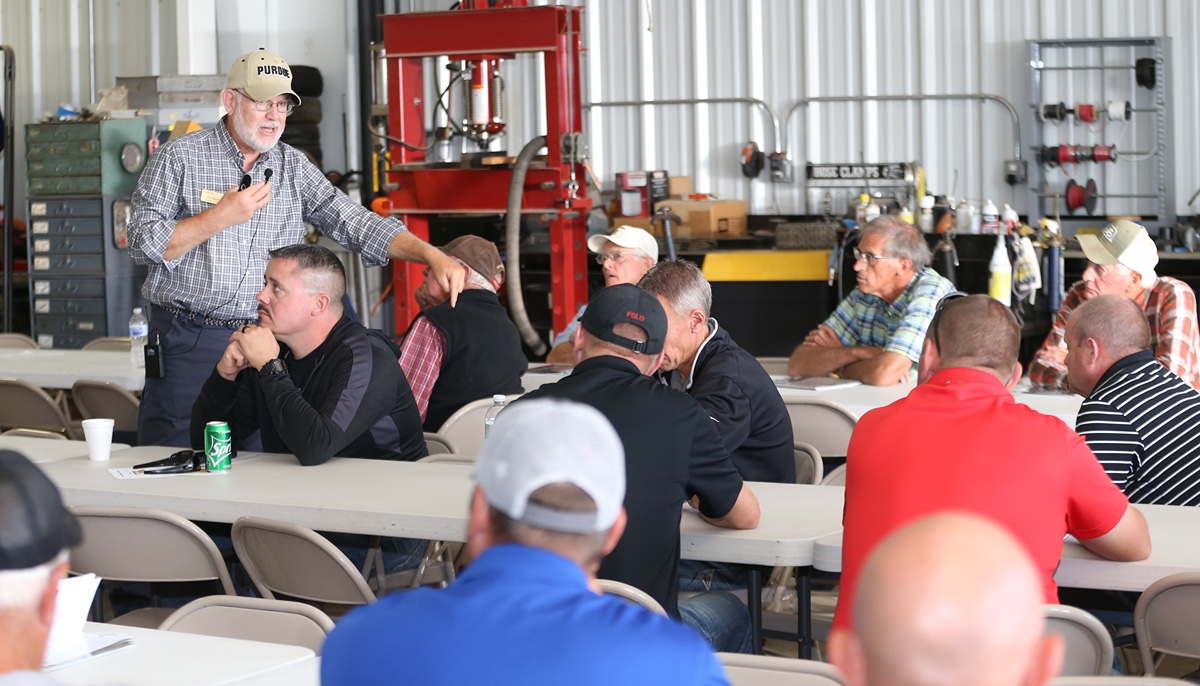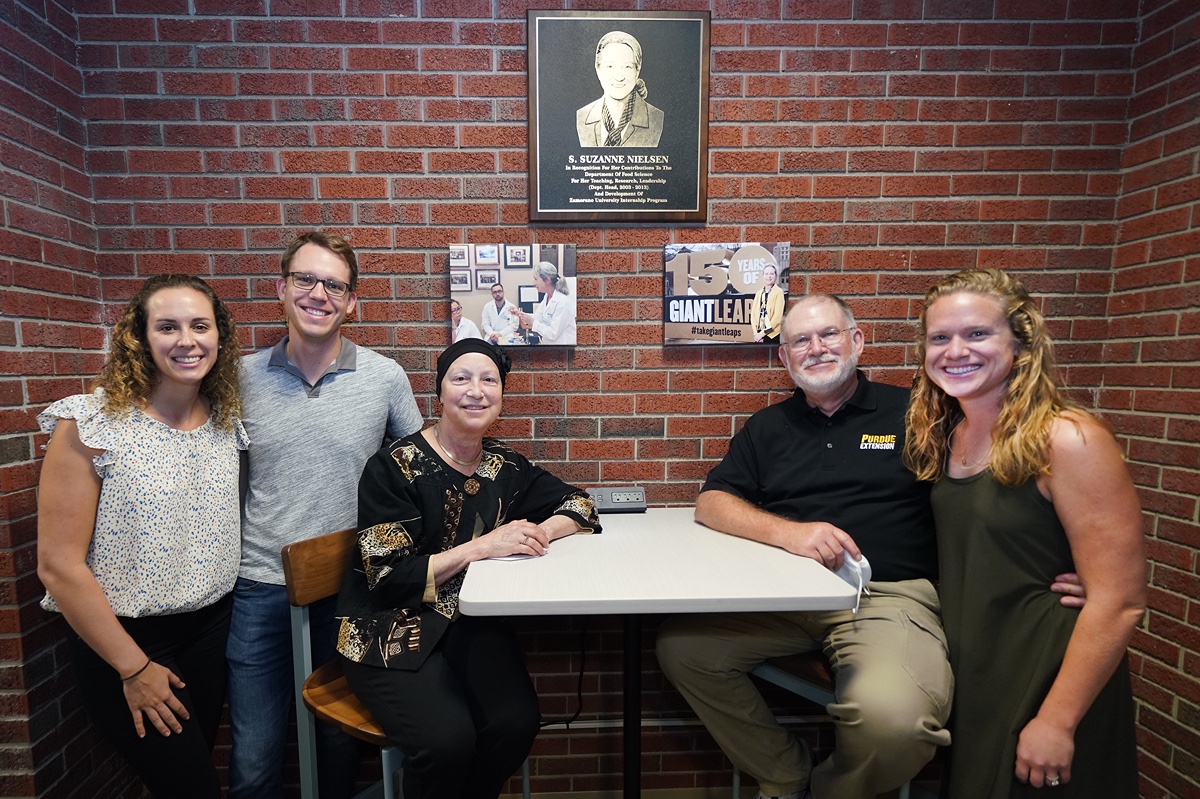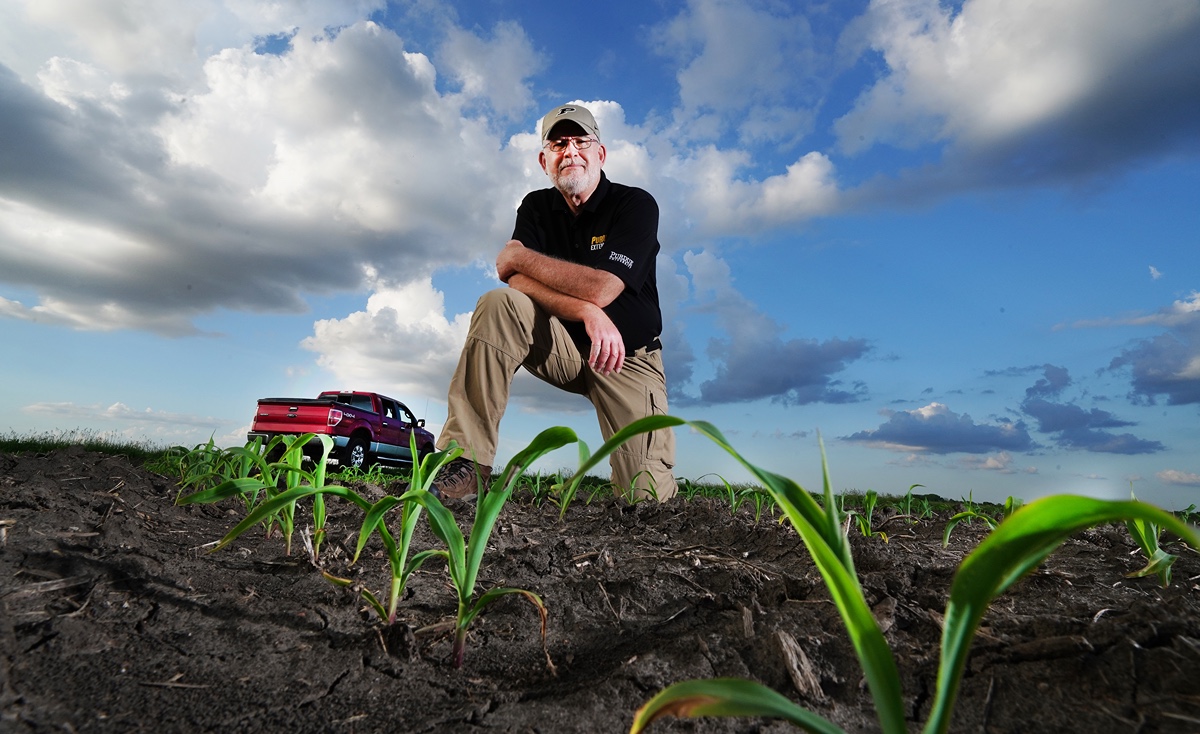The Corn Guy Moves On
Bob Nielsen, Purdue’s Extension Corn Specialist, is retiring after 40 years at the University
Despite being semi-retired, Bob Nielsen is a hard man to get ahold of in October. That’s corn harvest season, and Nielsen is in the field – literally – most days, riding shotgun in a combine harvester, monitoring corn yields. This means collecting data from yield monitors, as well as taking corn samples to study for nutrient content and other metrics.
“It all comes back to ‘how does corn respond, and what does that mean to the farmer?’” Nielsen says.
Nielsen, an Extension Corn Specialist and professor of agronomy in the College of Agriculture, prefers a simpler title: “Corn Guy” (it’s also his license plate). In December, he’ll become “fully retired Corn Guy,” taking his large collection of corn magnets and corn figurines and leaving the Lilly Hall of Life Sciences.
Behind Nielsen is a 40-year career as one of the country’s – and the world’s – premier corn experts. Over the years, Nielsen shared his knowledge of corn with more than 720,000 farmers and their advisors at over 2,000 Extension programs in Indiana and elsewhere in the U.S. He’s also well-recognized internationally, with invited participation in farmer conferences in Canada, Hungary, Argentina, New Zealand, Russia, Italy, South Africa and Mexico.
 Nielsen has been speaking at Extension gatherings like this 2019 event at the Davis-Purdue Farm for more than 40 years. By his estimations, Nielsen has spoken at 2,061 Extension programs that have reached an estimated 720,439 people. Photographs by Tom Campbell
Nielsen has been speaking at Extension gatherings like this 2019 event at the Davis-Purdue Farm for more than 40 years. By his estimations, Nielsen has spoken at 2,061 Extension programs that have reached an estimated 720,439 people. Photographs by Tom Campbell “If I had a dollar for every time someone told me ‘you have big shoes to fill,’ says Daniel Quinn, Nielsen’s successor, laughing. “The amount that he’s done, the amount of respect he has in the corn agronomy world is second to none.”
Purdue Agriculture Senior Associate Dean and Director of Extension Jason Henderson is likely one of those people who made that comment to Quinn. “Bob has had tremendous impact on Extension and Indiana agriculture--from on-farm research trials, presenting at farm field days or just chatting with farmers on the farm sitting the tail gate of a pick-up truck”.
“The best choice I ever made”
Nielsen grew up on a farm in eastern Nebraska, where his family grew soybeans, sorghum, alfalfa and – yes – corn, and always knew he wanted to work in agriculture. Since the family farm was too small to return to as a career, he decided to study agronomy at the University of Nebraska. While there, he was inspired by a professor to study plant breeding, and he fell in love.
“I got so excited about plant breeding as a possible career, after four years at Nebraska I ended up going to the University of Minnesota in plant breeding,” he says.
But as the end of his PhD neared, he began seeing ads for Extension jobs.
“You know how sometimes it just clicks in your head and a lightbulb comes on?” he says. “I thought OK, I think this is what I was cut out for.”
He felt a little guilty for leaving plant breeding, but he never looked back. He joined Purdue’s Agronomy faculty in 1982.
“It was the best choice I ever made,” he says.
There was just one issue. His wife, Suzanne Nielsen, who he’d also fallen in love with in college at Nebraska, had a brand-new PhD – hers in Food Science – and she also needed a job.
“You can imagine, 40 years ago coming out of grad school with a two-career couple, that was not common,” Nielsen says.
The couple decided Nielsen would stay at Purdue for four or five years and then, if nothing opened up for Suzanne, they would follow her career elsewhere. But fortune smiled. Within a year, Purdue launched its food science program, and Suzanne “got in on the ground floor.”
Suzanne Nielsen retired last year after a distinguished career, including a decade as Food Science department head. Her honors include numerous teaching awards, as well as being the first woman in the college to receive the annual Agricultural Research Award.
 Nielsen and wife Suzanne, dedicated the Suzanne Nielsen Student Lounge in Nelson Hall with the help of their son, Eric and his wife, Carly (left) and daughter Kirsti Pearsall on Sept. 8.
Nielsen and wife Suzanne, dedicated the Suzanne Nielsen Student Lounge in Nelson Hall with the help of their son, Eric and his wife, Carly (left) and daughter Kirsti Pearsall on Sept. 8. “Nothing short of miraculous”
One of Nielsen’s most notable achievements is being one of the first people to bring agronomy online, back in the 1990s. He remembers very well his ‘aha’ moment with the internet.
“One of my colleagues had an Apple MacIntosh, and I remember him coming down the hallway and he said, ‘hey, come take a look at this,’” he says.
On the small computer screen was a weather radar image displayed in something called a “Web page.”
“And I said, ‘how recent is this radar image?’” Nielsen recalls. “And he said, ‘it’s an hour old.’ Back then, that was nothing short of miraculous.”
He knew then that the World Wide Web would change everything. He began to work with the entomology department, who had several tech experts interested in the possibilities of the web. They showed him how to do some basic coding and gave him space on their server.
“It wasn’t too many months after that that I launched my first set of web pages where my goal was to begin compiling as much information about corn in the Midwest as I could,” he says. “Not only can we give our clientele information that we produce at Purdue, but we can give them what every land grant university in the country says.”
He built an online newsletter called the Chat n’ Chew Café, where land-grant universities could share corn information in a way never possible before. Researchers and farmers could read the latest information about fertilizers and yields, find tips on how to combat crop loss from drought or flooding, and look at pictures to diagnose all manner of corn problems, from Translucent Kernel Syndrome to “beer can ear.”
Back in 1995, Nielsen knew that his clientele – the farmers of Indiana – might not be accessing the internet any time soon. But he wanted to have the information available for them when they did. In its heyday, Bob’s website, KingCorn.org, was attracting between 300,000 and 400,000 views each year.
Today, Nielsen has no fewer than three screens on his desk, one of them showing a continuously updated, multicolor weather radar. And his clientele? They all have the internet in their pockets every time they climb onto the tractors or walk through their fields.
“His web materials have been used extensively for many years,” says James Camberato, a professor of agronomy and close collaborator of Nielsen’s. “He’s contributed substantially to the benefit of farmers in the state of Indiana, the Midwest, and corn farmers really worldwide.”
“Bob’s pioneering use of the internet and social media to convey agricultural information was groundbreaking. His problem solving abilities are seen every day as those he helped are able to capture more efficiency in their yields. His dedication to supporting Indiana agriculture is unrivaled.”
- Ron Turco, department head and professor of agronomy
Blowtorching the corn
Another of Nielsen’s top achievements is his involvement in starting Purdue’s Crop Diagnostic Training and Research Center. He and his colleagues established the center in 1985 as a place where farmers could come to learn, in a hands-on way, about common problems affecting crops. It features demonstration plots displaying crops damaged by insects, disease, weeds and weather.
Creating these demonstration plots took some creativity – agricultural “special effects,” if you will. Nielsen and colleagues attempted to mimic the look of hail damage by blasting the corn with an ice machine, or hitting it with a weed wacker with nuts tied to the string.
“You actually can duplicate those symptoms pretty nicely,” he says.
To create “frost” damage, they’d blast the crops with a portable torch. To show the effects of overly compacted soil, they’d drive tractors back and forth across the plots. They’d kill corn seeds with heat, then mix them with healthy seed to grow sad-looking gappy rows. They’d work with entomologists to do controlled insect releases inside areas surrounded by fine mesh netting, to create insect-damaged crops.
“We’d come up with all kinds of wild ideas” Nielsen says. “Who else gets to figure out how to damage things on purpose?”
The center has been an enormous success, attracting investment from industry and attention both national and international. “It’s a very effective teaching tool,” Nielsen says.
Shaun Casteel, Purdue’s Extension soybean specialist, says Nielsen has a unique gift for creative communication. “He’s always wanting to find a different or better way of presenting information so that it would become knowledge,” he says.
Nielsen’s knack for sharing knowledge extends to his colleagues, Casteel says. Casteel arrived at Purdue fresh out of grad school in 2009, and found in Nielsen a valuable mentor.
“Bob took me under his wing,” he says. “I modeled a lot of the work I do based on what he’s done.”
 In addition to being Purdue’s corn expert, Nielsen also provided hands-on lessons in flying unmanned aerial vehicles (UAV’s) at Extension events like this field day in 2018. Receiving the flying lesson is Mike Beard, a Frankfort farmer and member of Board of Directors for Indiana Corn Marketing Council. Photographs by Tom Campbell
In addition to being Purdue’s corn expert, Nielsen also provided hands-on lessons in flying unmanned aerial vehicles (UAV’s) at Extension events like this field day in 2018. Receiving the flying lesson is Mike Beard, a Frankfort farmer and member of Board of Directors for Indiana Corn Marketing Council. Photographs by Tom Campbell Applied research supports Extension and graduate student training
Results from field trials conducted throughout the state provided much of the information Nielsen shared with farmers and their advisors. In recent years, that research focused on identifying the most cost-effective use of expensive crop production inputs like seed and fertilizer. Along with colleague Jim Camberato, Nielsen was on the forefront of using high-tech precision agriculture tools to conduct large field-scale trials at the various Purdue Ag. Research Centers and in collaboration with farmers on their own fields with minimal logistical challenges for the cooperators. Since 2006, the two researchers conducted more than 550 such trials in 48 of Indiana’s 92 counties.
Nielsen’s applied field research trials also served as a training ground for the 27 graduate students he mentored or co-mentored over the years. Most of those students have gone on to successful professional careers in the ag industry. “These graduate students are almost like your own kids,” he says. “There’s a great sense of pride when they go out into the world and have a major impact on agriculture themselves.”
A changing agricultural landscape
Challenges for farmers have changed over the course of Nielsen’s career, largely due to climate change.
“One of the manifestations that’s hitting agriculture the hardest is the ever-increasingly variable weather from one year to the other,” he says. “We can pretty confidently predict there’ll be an extreme weather event next summer, but we don’t know what it will be – extreme drought, too much water, storms, severe heat, lethal cold. For a grower who’s trying to consistently produce let’s say 250 bushels of corn, it gets to be a real challenge.”
This has meant Nielsen has focused an increasing amount of attention on how extreme weather affects corn. He’s used these weather events – such as the record-setting rains of 2019 – to get data to use in future years.
Other challenges have come from changing regulations. The acid rains common when Nielsen started his career in the early 1980s, which damaged forests and buildings, killed aquatic life, and polluted drinking supplies, have largely abated due to stronger air pollution laws. This is, of course, a good thing, but it has had some surprising effects. Acid rain contained sulfur, which is an important nutrient for many crops, including corn. Lack of acid rain meant farmers suddenly needed to figure out when and how much to add sulfur to their fields.
“It’s good that we’ve cleaned up the air, but now we need to study this particular nutrient,” Nielsen says.
 It is difficult to think of corn in Indiana without thinking of Bob Nielsen. In fact, the vanity plate on his red pickup truck in this 2020 photo reads “CORN GUY.” Photographs by Tom Campbell
It is difficult to think of corn in Indiana without thinking of Bob Nielsen. In fact, the vanity plate on his red pickup truck in this 2020 photo reads “CORN GUY.” Photographs by Tom Campbell A Lifetime in Agronomy
Nielsen’s colleagues all say his exit will be bittersweet.
“It’ll be a great loss for the industry and Purdue for Bob to retire, but it’ll be another step in his life of course,” says Camberato. “We all have to retire eventually.”
When Nielsen leaves Purdue, he’ll join his wife in traveling, volunteering, and enjoying time with their two grown children. He also hopes to spend time on a personal hobby, family genealogy. He’s traced his family all the way back the late 1700s in Denmark, where his 5th great-grandfather was a serf on a feudal estate. When the feudal system ended, his ancestor was granted the land he’d been farming. Today, Nielsen’s 4th cousin still lives on that land, where he’s retired from growing small grains like wheat and barley. Clearly agriculture is in the blood.
“It’s pretty cool to be on a piece of ground – a farmstead – and realize it goes back at least five generations,” says Nielsen, who had the opportunity to visit his cousin.
Even with plenty to do in retirement – leaving Purdue won’t be easy.
“When you’re out in the state doing this kind of Extension work, you get pretty invested in the state,” Nielsen says. “Every corn field you drive by, you sort of think it’s your responsibility to make sure it does well.”
But Nielsen leaves knowing his program is “in good hands” with Daniel Quinn, which he says makes the transition easier. And he also leaves knowing he’s influenced Indiana agriculture for the better.
“So much of the satisfaction I’ve had has been when a farmer or agronomist comes up and thanks me for some piece of advice I gave them years ago and how much it helped them. That’s when you can leave with a lot of satisfaction, like you’ve really done your job.”
- Bob Nielsen, professor of agronomy and Extension corn specialist






